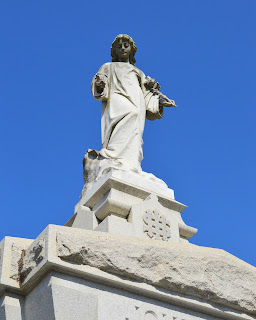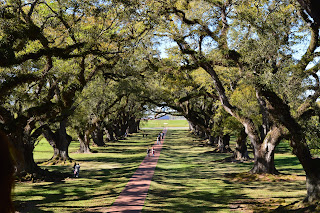We got checked in and soon were on our bus. It was comfortable, with enough leg room to keep from feeling squished. We were greeted by our driver and guide, a feisty older woman with bright blond hair that flashed at us as she drove.
We started down the road and she started telling us facts and tidbits with each turn of the wheels. The bus meandered quickly and efficiently through the narrow streets of The Big Easy. Her accent again made it a little difficult for me to catch everything, but she was funny, knowledgeable, and opinionated.
She told us how true people of New Orleans didn't do well giving directions. "We don't know north from south," she explained. "You will come to corners of streets where a street named South Elm will intersect with a street named South Walnut," she laughed in a boisterous laugh. "If you need to ask for directions," she went on in a thick southern drawl, "your best bet is to ask one person, walk down to the first turn and then ask another person. Keep doing that until you find where you want to go."
She told us stories of each building of significance along the way. She laughed about odd laws in Louisiana. How "gambling" is illegal, but "gaming" is not as we went passed Harrah's casino. The fact that they have places that will sell you a daiquiri through a drive thru window. You read that right, not virgin daiquiris either. On Grand Isle we saw a couple of drive thru daiquiri establishments. They were all closed for the season, so we weren't able to investigate, so I had been very curious how that worked. Did Louisiana not have open container laws? This would now be explained to me. She laughed in her now familiar way, "we do have open container laws, so how do you think they get around that?" I listened intently as I was baffled. "They use a lid and a straw. The straw is already in the cup, with part of the straw paper still on it. As long as that piece of straw paper is still on the straw, it is considered a closed container." She laughed again and went on, "now, believe me," she said, "once those straw papers are off, you can't get them back on, I've tried." The bus laughed with her.
I didn't try taking photos out the tinted windows. There were two stops though, where we were allowed to leave the bus and look around. The first was at St. Louis Cemetery. Before we got there, our guide taught us about how burial was done in southern Louisiana. "We can't bury our dead like you do up north. They tried, and the coffins kept coming back up to the surface and bobbing along. That wasn't something people enjoyed seeing or dealing with," she explained. "So, we put our dead in vaults. They are first put in a holding area for a year," she peaked back at us in her mirror looking for reaction. "Back in the day, people might be accidentally buried alive. They looked dead, but then as the family was getting ready for the funeral, they'd open the casket and find scratch marks on the inside. That was when the tradition of holding a body before placement in the vaults became practiced. The law is still on the books today, and is still done."
She went on, "Now, the vaults are owned by families. The family has their loved one's casket put into the vault after the waiting period. Here in New Orleans, we get pretty hot summers. These vaults are made of concrete. The insides of the vaults get very hot. A body in a wooden casket goes through what we call 'natural cremation.' The casket and the body eventually disintegrate. Then when the next family member dies, they are put into the vault, they disintegrate, and so on. You can be in the same vault with your great great grand daddy."
That was creepy enough for me, then it got creepier. "Now, when all of your family has died off, if no one has ever paid for the vault in perpetuity, the grave yard can sell your vault and new people can be added. You could end up in eternity with a complete stranger." She looked back at us again studying us for response. I know she was gratified with my response. I must have looked in horror. "It's not weird to us, it's just how it's done." With that she let us off the bus to look at the history within the gates.
Some of the vaults are meticulously kept up, and some left to dirt and decay, much like cemeteries I know. Some are grandly adorned with angle statues, others with simple crosses.
New Orleans was, and probably still is a very Catholic town. There was also a statue of Mother Teresa with flowers that had been left by admirers.
The next stop on the bus tour was City Park. We were told that episodes of NCIS- New Orleans were filmed there. I didn't see Scott Bakula though, whats up with that?
We didn't have much time to explore City Park. Bathroom breaks were necessary and a snack of a freshly cooked beignet.
Then it was back on the bus for the rest of the tour. The driver took us by some houses that had waterlines from the flooding during Katrina. We were not taken into areas still damaged, all these years later, to gawk at the misfortunes of others. I don't know if this was a matter of respect or a way to hide how many are still waiting for help. Judging by the way the driver spoke of Katrina, I believe it was out of respect. She held nothing back when expressing her feelings of how it was dealt with. She reminded us that it wasn't the storm itself that caused the damage. I remember that, I watched Shepard Smith in the middle of downtown relieved and happy that the worst didn't happen. The city has let out a sigh of relief. Then the levies started to fail. It was the disintegration of the levy system that destroyed so much and killed so many, not the storm. She showed us the repairs made and doubted they would help much in the next storm.
Down the last road on our way back we went down the parade route for Mardi Gras. The trees were heavy with colorful, shiny beads dancing in the breeze. The driver told us that the city stopped trying to remove the beads. "By the time they'd get them all down, it would be time for Mardi Gras again. They are leaving them for the tourists, hoping they take them all."

























































